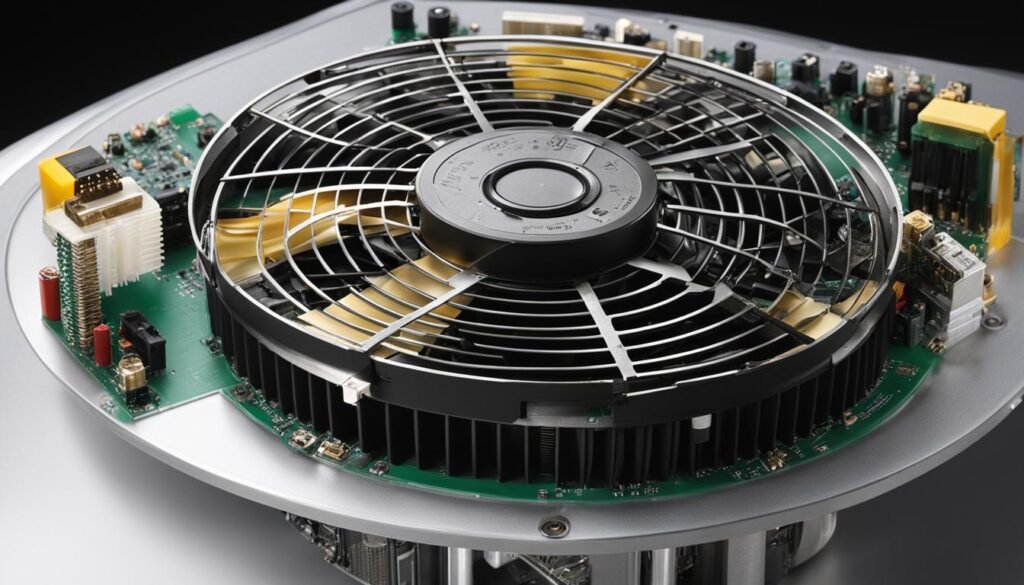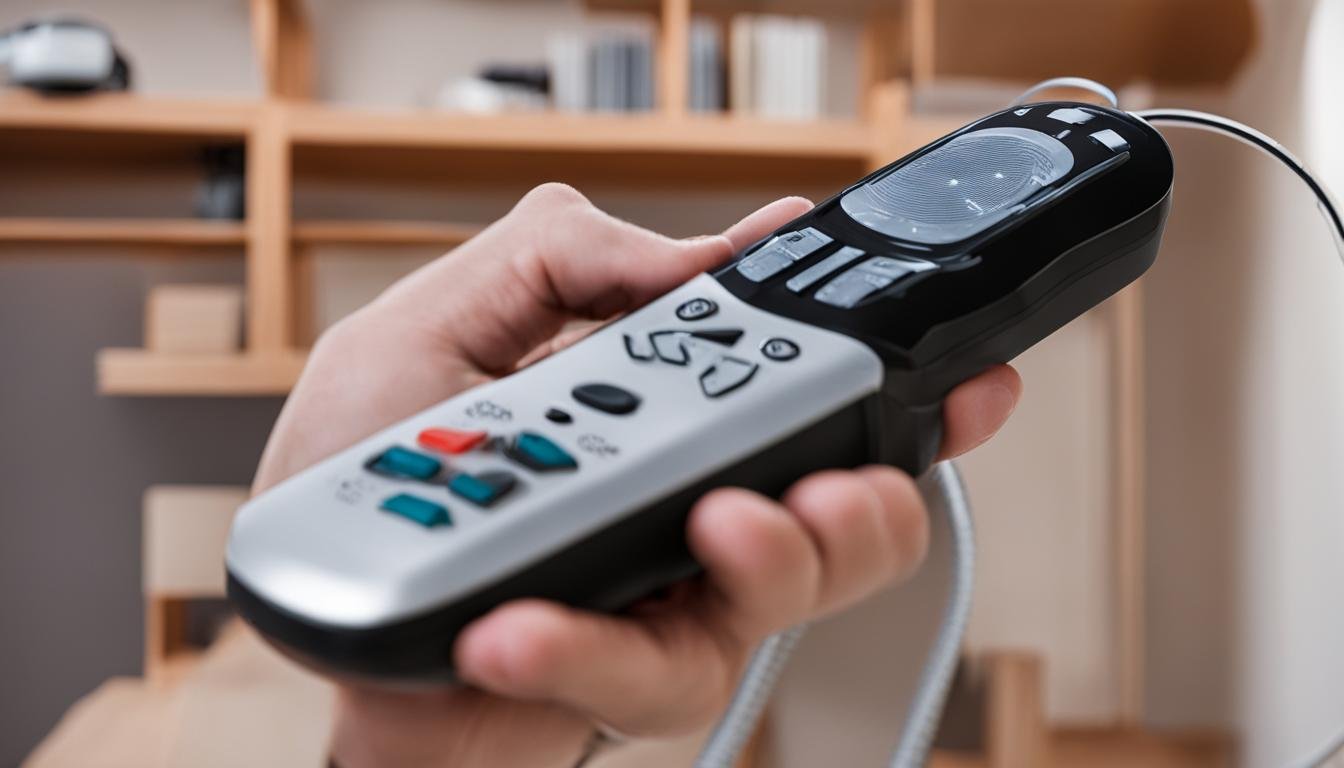Welcome to this tutorial on how to make your very own remote control vacuum cleaner. If you’re interested in a fun and rewarding DIY project, then this is the perfect guide for you. By following the steps outlined here, you’ll be able to create a homemade remote control vacuum cleaner that will help keep your space clean and tidy.
To make your remote control vacuum cleaner, you’ll need a few materials and components, such as an Arduino Uno board, IRF520 MOS FET driver module, H-bridge L298 dual motor driver, micro metal gearmotor HP 6V 298:1, fan blower, Sharp distance sensor, LiPo battery pack, 3D printer, and various other tools and materials. These components will come together to create a fully functional cleaning robot that can autonomously navigate and clean a room.
Key Takeaways:
- Creating a remote control vacuum cleaner is a rewarding DIY project.
- The necessary materials and components include an Arduino Uno board, motor drivers, sensors, and a fan blower.
- Building your own vacuum cleaner allows for customization and cost savings compared to commercial options.
- By following this tutorial, you’ll learn about robotics and programming.
- A remote control vacuum cleaner offers convenience and efficiency in cleaning your space.
How Does a Vacuum Robot Work?
A vacuum robot operates on similar principles as a traditional vacuum cleaner, but it offers additional features and functionality to enhance cleaning efficiency. The core mechanism revolves around the use of a fan motor that generates airflow to suck in dirt and debris from the surrounding environment. This accumulated dirt is then filtered and expelled through an exhaust port, ensuring a clean and dust-free living space.
However, what sets a vacuum robot apart is its integration of a microcontroller and sensors. These components grant the robot the ability to analyze its surroundings, make informed decisions, and navigate autonomously. The incorporation of advanced algorithms enables the vacuum robot to efficiently map rooms, plan optimal cleaning paths, and adapt its cleaning patterns to maximize coverage.
Additionally, vacuum robots often come equipped with a wide range of features and functionalities that further enhance their performance. Some models have side brushes to sweep dirt from corners and edges, ensuring comprehensive cleaning. Collision detection sensors help the robot avoid obstacles, preventing inadvertent damage to furniture or other objects. Furthermore, many vacuum robots are designed to automatically return to a charging base when their battery is low, ensuring uninterrupted cleaning sessions.
| Key Features of a Vacuum Robot | Description |
|---|---|
| Autonomous Navigation | Vacuum robots employ sensors and algorithms to navigate and clean without human intervention. |
| Advanced Algorithms | Intelligent algorithms enable efficient room mapping, path planning, and cleaning optimization. |
| Side Brushes | Additional brushes to reach corners and edges for thorough cleaning. |
| Collision Detection | Sensors detect obstacles to avoid collisions and potential damage. |
| Automatic Charging | Vacuum robots can independently return to a charging base when their battery is low. |
The innovative combination of a fan motor, microcontroller, sensors, and intelligent algorithms makes vacuum robots highly efficient and convenient cleaning companions in modern households. With their ability to autonomously navigate, adapt, and perform targeted cleaning, these robots offer a seamless and time-saving solution for maintaining cleanliness and tidiness.
About the Materials and Components
When building a remote control vacuum cleaner, it is important to choose the right materials and components. Here are the key elements you’ll need:
Vacuum Cleaner Fan
The fan is a crucial part of the vacuum cleaner as it creates the necessary airflow for effective cleaning. It’s important to select a fan with a decent airflow (CFM) to ensure optimal performance.
Fan Driver
To control the on/off state of the fan, you’ll need a fan driver. The MOS-FET IRF520 is a popular choice among DIY enthusiasts for its reliability and functionality.
Motor Driver
The motor driver plays a vital role in controlling the direction of the vacuum cleaner’s motors. The H-bridge L298 is commonly used for this purpose due to its versatility and compatibility.
Ultrasonic Sensors
Ultrasonic sensors, such as the HC-SR04, are essential for obstacle detection in a remote control vacuum cleaner. These sensors use ultrasonic waves to detect objects in the robot’s path and help it navigate accordingly.
Battery Voltage Divider
A voltage divider is necessary to monitor the battery’s voltage and prevent any potential damage to the LiPo battery pack. This component ensures the safe and efficient operation of the vacuum cleaner.
Robot Frame Materials
The robot frame provides structural support and holds all the components together. Materials like MDF (Medium-Density Fiberboard), foam sheet, or cardboard can be used to construct the robot frame, depending on your preference and availability.
By carefully selecting these materials and components, you’ll have a solid foundation for building your own remote control vacuum cleaner.
| Component | Description |
|---|---|
| Vacuum Cleaner Fan | Crucial for creating airflow for effective cleaning |
| Fan Driver | Controls the on/off state of the fan |
| Motor Driver | Controls the direction of the motors |
| Ultrasonic Sensors | Detects obstacles for navigation |
| Battery Voltage Divider | Monitors battery voltage to prevent damage |
| Robot Frame Materials | Provides structural support for the vacuum cleaner |

By choosing the right materials and components, you can ensure the successful construction of a remote control vacuum cleaner that meets your needs and performs efficiently.
Conclusion
Building a remote control vacuum cleaner can be a fascinating and fulfilling DIY project. By following the steps outlined in this tutorial, you can create your very own cleaning robot using easily accessible materials and components. The process allows for customization and cost savings compared to commercial products, while also providing an opportunity to learn about robotics and programming.
One of the advantages of a homemade vacuum cleaner is the ability to control it remotely, offering a convenient and efficient cleaning experience. You can effortlessly navigate your home, reaching those hard-to-reach places with ease. Plus, you can enjoy the convenience of programming cleaning schedules and controlling the vacuum cleaner from the comfort of your couch.
Embarking on a DIY vacuum cleaner project not only gives you the satisfaction of building something functional, but it also offers a valuable learning experience. As you assemble the components and program the robot, you’ll gain insights into how robotics and automation work. This knowledge can be applied to other projects or even spark a passion for further exploration in the field.
So why not seize the opportunity to build your own remote control vacuum cleaner? With a homemade cleaning robot, you can revolutionize your cleaning routine while immersing yourself in the world of robotics. Get started on your journey today and discover the many benefits of building a robotic vacuum cleaner.
FAQ
Can I build a remote control vacuum cleaner myself?
Yes, you can build your own remote control vacuum cleaner using the materials and components mentioned in the tutorial.
What materials do I need to make a remote control vacuum cleaner?
The materials you will need include an Arduino Uno board, IRF520 MOS FET driver module, H-bridge L298 dual motor driver, micro metal gearmotor HP 6V 298:1, fan blower, Sharp distance sensor, LiPo battery pack, 3D printer, and other tools and materials.
How does a vacuum robot work?
A vacuum robot works by using a motor with a fan to create airflow, which is then used to pick up dust and dirt. It also includes a microcontroller and sensors that allow it to autonomously navigate and clean a room.
What are the main differences between a vacuum robot and a traditional vacuum cleaner?
A vacuum robot has a microcontroller and sensors that allow it to make decisions and navigate autonomously. It often has advanced algorithms for mapping rooms, planning paths, and performing efficient cleaning. It may also have additional features like side brushes, collision detection, and the ability to return to a charging base.
How do I choose the right materials and components for my remote control vacuum cleaner?
When choosing materials and components, consider factors such as the fan’s airflow (CFM) for effective cleaning, the fan driver to control the on/off state of the fan (such as the MOS-FET IRF520), the motor driver to control the direction of the motors (like the H-bridge L298), and ultrasonic sensors for obstacle detection (such as the HC-SR04). Also, consider using a voltage divider to monitor the battery voltage and prevent damage to the LiPo battery. The robot frame can be made from materials like MDF, foam sheet, or cardboard.
Why should I build a remote control vacuum cleaner myself?
Building a remote control vacuum cleaner can be a fun and rewarding DIY project. It offers the benefit of customization and cost savings compared to commercial products. It also allows you to learn about robotics and programming. With the ability to control the vacuum cleaner remotely, you can enjoy a convenient and efficient cleaning experience.





Leave a Reply